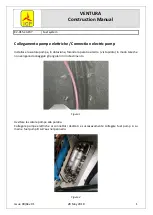
12
when trying to remove a knot. When there are knots in the lines or
when they are tangled, do not pull too hard on the brake lines because
there is an increased risk of the wing to stalling or negative turn being
initiated
Before trying to remove a knot, make sure there are no pilots flying
nearby and never try these manoeuvres near the mountainside. If the
knot is too tight and you cannot remove it carefully and safely fly to the
nearest landing place.
5. LOSING HEIGHT
The knowledge of the different descent techniques is an important
resource to use in certain situations. The most adequate descent method
will depend on the particular situation.
We recommend that you learn to use these manoeuvres under the tuition
of a competent school.
5.1 SPLIT A
Big ears are a moderate descent technique, achieving about –3 or –4
m/s and a reduction in ground speed of between 3 and 5 km/h. Effective
piloting then becomes limited.
During Big Ears the angle of incidence and the wing loading increases,
however application of the accelerator will restore the wing’s horizontal
speed and the angle of incidence.
The A riser of the LINK is divided, which let you easily find the
suspension line to make the Split A.
To apply big ears select the outermost A-line from each stabilizer as high
up as possible and pull them outward and downward in a smooth and
symmetrical motion. The wingtips will then fold inwards.
Releasing the outer A riser will see the wingtips re-inflate automatically.
If they do not re-inflate gently pull on one of the brake lines and then on
the opposite side. We recommend that you re-inflate asymmetrically this
will reduce the risk of altering the angle of incidence which should be
avoided, more so if you are flying near the ground or flying in turbulence.
5.2 B-LINE STALL
When you carry out this manoeuvre, the wing stops flying, it loses all
horizontal speed and you are not in control of the paraglider. The air
circulation over the profile is interrupted and the wing enters into a
situation similar to parachuting.
To carry out this manoeuvre you have to take the B-risers below the
maillons and symmetrically pull both of them down (approx. 20-30 cms)
and then hold this position. The initial phase is quite physical (hard
resistance) which means that you will have to pull strongly until the profile
of the wing is deformed, when this happens the required force will then
significantly reduce. To maintain this manoeuvre you must continue to
hold the B Lines in the pulled down position. The wing will then become
deformed, horizontal speed drops to 0 km/h and vertical speed increases
to –6 to –8 m/s depending on the conditions and how the manoeuvre has
been performed.
To exit the manoeuvre, simultaneously release both risers, the wing will
then slightly surge forward and then automatically return to normal flight.
It is better to let go of the lines quickly rather than slowly. This is an easy
manoeuvre but you must remember that the wing stops flying, it loses
all horizontal movement and its reactions are very different compared to
normal flight.
5.3 SPIRAL DIVE
This is a more effective way for rapidly losing height. You have to know
that, the wing can gain a lot of speed and the increase in G’s will be
substantial.
This can cause a loss of orientation and consciousness (blackouts).
These are the reasons why it is best to carry out this manoeuvre
gradually so your capacity to resist the G forces increases and you will
learn to fully appreciate and understand the manoeuvre. Always practi-
ce this manoeuvre when flying at high altitude.
Содержание LINK 23
Страница 1: ...USER S MANUAL LINK...
Страница 17: ...17 11 3 RISER ARRANGEMENT...
Страница 18: ...18 11 4 LINE PLAN...
Страница 23: ...23...
Страница 24: ...The importance of small details niviuk com...






































